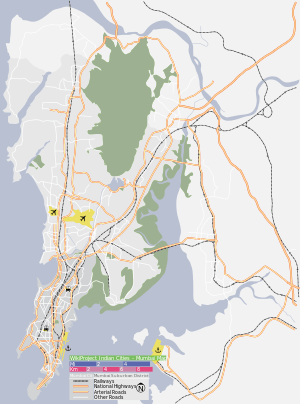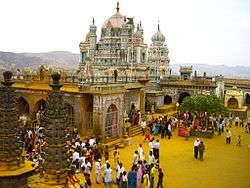Mumba Devi Temple
| Mumba Devi Temple मुंबा देवी मंदिर | |
|---|---|
 | |
 Mumba Devi Temple मुंबा देवी मंदिर Location within Mumbai, Maharashtra | |
| Name | |
| Other names | Mumba Devi Mandir |
| Marathi | मुंबा देवी मंदिर |
| Geography | |
| Coordinates | 18°57′0″N 72°49′48″E / 18.95000°N 72.83000°ECoordinates: 18°57′0″N 72°49′48″E / 18.95000°N 72.83000°E |
| Country |
|
| State | Maharashtra |
| District | Mumbai |
| Locale | Bhuleshwar |
| Culture | |
| Primary deity | Mumbadevi |
| History and governance | |
| Date built | c. 1635 |
Mumba Devi Mandir is an old temple in the city of Mumbai, Maharashtra dedicated to the goddess Mumbā, the local incarnation of the Devi (Mother Goddess). Marathi Mumbā derives from Sanskrit While Hindu sects devoted to the goddess Mumbadevi are attested to as far back as the 15th century, it is said that the temple was built in 1675 near the main landing site of the former Bori Bunder creek against the north wall of the English Fort Saint George by a Hindu woman also named Mumba. The creek and fort are now deteriorated to a point at which they are but derelict reminders of the city's past. The temple, on the other hand, is still active.
The goddess Mumba was patron of the agri (salt collectors) and kolis (fisherfolk), the original inhabitants of the seven islands of Bombay. She is depicted as a black stone sculpture in the temple. An etymology of Mumba that is popular is "Maha Amba," or "Great Mother," one of the many of India's more well-known names for the Hindu Mother Goddess (Devi). Located in Bhuleshwar area in South Mumbai, the temple is in the heart of the steel and clothing markets. It is a sacred pilgrimage spot and place of worship for Hindus and is thus visited daily by hundreds of people. It is not uncommon for visitors of Mumbai to pay their respects at the temple and is one of the popular tourist destinations in the city.[1]
Mumbadevi Temple Maharashtra, Maa Mumbadevi temple is another Shakti temple situated in Mumbai. The name of the city Mumbai is derived from Maa Mumbadevi. Mumbai (Marathi: मुंबई ['mumbəi]; of Portuguese words and Bom Bahia, meaning "good harbor" .This temple is dedicated to city's patron Goddess Mumbadevi. The temple of Mumbadevi, once stood on the site of the present Chhatrapati Shivaji Terminus in the central island which was called Mumbai. The temple was built in honour of Mumbadevi, the patron goddess of the Koli fishermen believed to be the original inhabitants of Mumbai. The original temple was built in 1737 was demolished and a new temple erected in its place at Bhuleshwar. The nearest station is Marine Lines. Although the Mumbadevi Temple is not as striking as others are in the city, its resident deity, Mumbadevi, is the city's patron Goddess. The structure is about six centuries old, believed to be the handiwork of Mumbaraka, a sadistic giant who frequently plundered the city at the time.
History
This temple was built in honour of the Goddess Amba. The Mumbadevi temple is six centuries old. The first Mumbadevi temple was situated at Bori Bunder, and is believed to have been destroyed between 1739 and 1770. After the destruction a new temple was erected at the same place at Bhuleshwar. The Goddess personifies Mother Earth and is still worshipped by the Hindu population of the northern Indo-Gangetic plain and southern India alike. The original temple built at the site where the Victoria Terminus station earlier was by Koli fishermen was demolished around 1737 and a new temple was erected in its place at Phansi Talao. The modern shrine contains an image of the Goddess Mumbadevi dressed in a robe with a silver crown, a nose stud and a golden necklace. To the left is a stone figure of Annapurna seated on a peacock. In front of the shrine is a tiger, the carrier of the Goddess.
The present name of the city is derived from the Goddess Mumbadevi. The temple itself is not impressive but is an important landmark as it is dedicated to MumbaDevi, the city's patron deity.
Places to see
The Mumbadevi road is to the right from the northern end of Zaveri Bazaar. It is a narrow street lined with stalls selling a spectrum of objects associated with Hindu religion – copper bracelets, rings, rudrakska malas, brass lingams, photographs of deities, incense, saffron and so on. Ochre clad sadhus flit along the street, their foreheads smeared with ash paste and vermilion.
References
| Wikimedia Commons has media related to Mumba Devi Temple. |


